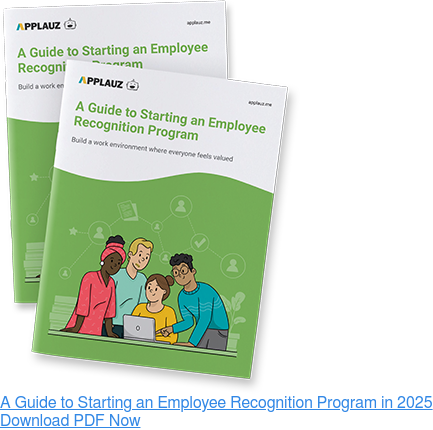Employee recognition is a critical part of a well-rounded employee engagement program. As such, many HR leaders are intent on developing strategies to prioritize appreciation in the workplace.
As a result, programs that help spread the power of appreciation are ![]() becoming increasingly common.
becoming increasingly common.
For example:
- Years of Service Programs
- Peer-to-Peer Recognition Programs
- Employee appreciation events
Despite all these initiatives, appreciation efforts can fall short.
For example, employee morale doesn't improve in any meaningful way. Or employees don't seem any more enthusiastic about work than before.
When this happens, leaders may wonder what they did wrong.
Why isn't the company seeing positive results?
The real purpose of appreciation
If you type "ideas for employee appreciation or recognition" into Google, you will find a variety of suggestions and approaches.
Many of these ideas are valid. However, too many HR leaders and managers put these ideas into practice without evaluating the most critical thing — what their employees actually want.
When leaders don't consult employees, the company's appreciation efforts may be misled.
The success of employee appreciation or recognition depends on how these actions speak to your employee's needs.
First, this means knowing about the different types of employee recognition.
But also, looking at expert research and the science of reward-giving. With this knowledge, your business can learn to give more impactful appreciation to deliver long-term value to all your company's employees.

5 Research-Based Ideas to Boost the Impact of Workplace Appreciation
1. Understand how employees prefer to receive appreciation
Gary Chapman author of the popular psychology book The 5 Love Languages, teamed up with Dr. Paul White and created a related book called The 5 Languages of Appreciation in the Workplace.
In the book, White explains how workplace recognition is often ineffective when leaders assume there is only one way to express appreciation to employees.
In other words, leaders think practicing appreciation means offering the same type  of recognition to everyone.
of recognition to everyone.
In real life, it looks something like this:
- Offering recognition only through "good job team" emails.
- The same "thank you for your efforts" message is sent to workers at the end of a project or difficult period.
- Only giving employees recognition through public shout-outs during team meetings.
In essence, everyone receives the same type of recognition via the same channel.
As a result, it feels generic, and it's not cherished.
This type of 'blanket' recognition evokes little positive feelings.
So, what is the key to giving strong recognition?
It's simple — understand your employee's unique 'language of appreciation.' And tweak recognition efforts to meet them.
Put this idea into practice
The first step to giving meaningful recognition is understanding how employees want to be appreciated.
Managers or supervisors will most often carry out these efforts. As such, managers should have a clear idea of the following:
- Understand which medium or context employees prefer to receive recognition. For instance, do employees enjoy public recognition during a group meeting? Or do they prefer getting recognition in a private setting, like during a one-on-one?
- Understand what type of appreciation motivates employees; what actions make them feel valued? For instance, would they like verbal praise, tangible gifts, or an experience-based reward like a social event.
- To gain this information, leaders or managers can poll, survey, or speak with their teams directly.
2. Express appreciation for the person, not just their output
Recognition programs at work are more popular than ever. But job satisfaction levels have declined over the same period.
In a book called The Vibrant Workplace, Dr. Paul White explores the secret sauce behind strong recognition programs and explores this mismatch. White aims to understand why these programs sometimes struggle to take off.
 White's research focuses on one central idea: recognition programs often backfire when leaders focus too much on praising output.
White's research focuses on one central idea: recognition programs often backfire when leaders focus too much on praising output.
Only praising output is all too common. It sounds something like this:
- "Great job on exceeding our quota for the quarter!"
- "Amazing job on the presentation."
- "Thank you for your speed and accuracy on this report."
Remember: White doesn't want leaders to stop praising output altogether.
The idea is to find the right balance.
Managers and supervisors should recognize output — yes. But also, add a few words that draw attention to why this employee is unique and what they did differently.
White warns that only praising output results in recognition feeling less and less authentic. And employees will grow distrustful of a manager's praise as a result.
White proposes an alternative. An idea he coined authentic appreciation. Authentic appreciation is about admiring an employee for more than what they produce. It's about highlighting their unique abilities, personality, and talents.
Put this idea into practice
For appreciation to have a positive emotional impact on an employee, praise must be personalized. In short, tailor your message to the person receiving it.
Because here's the reality: most people can complete a task. Workers want to be recognized for more than ticking something off a to-do list.
People want to feel special and unique. They want to know that you see their unique contribution and skills.
For example:
- "Amazing job exceeding your quota! We are so impressed by your problem-solving and work ethic."
- "Amazing job on the presentation; your delivery was impressive. You have a natural ability to command a room and be persuasive. We are lucky to have this talent on our team!"
- "Thank you for your speed and accuracy in this report. Your ability to focus under pressure is hard to come by and something to be admired."
Bottom line: Recognition and appreciation at work are most impactful when leaders highlight what the employee did differently.
 3. Incorporate small gifts with verbal appreciation
3. Incorporate small gifts with verbal appreciation
Verbal praise is one of the more popular ways of expressing employee appreciation. After all, it's the most time and cost-effective.
Verbal recognition is powerful. But, leaders should also leverage the power of small tangible rewards to take appreciation to the next level.
Even the smallest gifts can have a significant impact on employee motivation.
For instance, in a popular study, researchers wanted to know how doing favours for  other people impacts behaviour. The people participating were offered a simple favour — the researcher gave them a can of Coke. Although, participants didn't know the Coke-giving was part of the experiment!
other people impacts behaviour. The people participating were offered a simple favour — the researcher gave them a can of Coke. Although, participants didn't know the Coke-giving was part of the experiment!
At the end of the study, the participants were asked if they wanted to buy a raffle ticket.
Interestingly, the group who received a Coke were much more likely to buy a raffle ticket. The results held even when the researcher acted rudely towards the participants!
What does this have to do with appreciation at work?
Well, if you're reading this and your company doesn't have the time or budget to put in place a costly reward or recognition program — that's ok! You can leverage the power of appreciation with a small budget.
That's because giving begets giving. It's human nature. Even the smallest favours and acts of generosity evoke a strong response to return the favour.
Put this idea into practice
When these small, thoughtful gifts are paired with regular verbal recognition, you can be sure employees will notice and feel the genuine effort from management.
For instance, a small budget can be offered to managers so they can occasionally buy snacks, coffees, drinks, or other spontaneous treats for their teams.
The budget is small, but the returns will be big!
4. Be sure employees actually want the rewards you are offering
You're probably reading this and thinking — well, obviously, why would we offer employees rewards they don't want?
In reality, many companies out there spend a great deal of time and money on rewards that employees simply don't care for.
For example:
- A company offers a paid lunch and social event for all departments at the end of the quarter.
- A company offers gift cards that people don't want or wind up not using.
- A company implements a Years of Service program. Still, it only offers the choice of a handful of gift options for each anniversary milestone.
In these cases, the intention — to communicate appreciation to employees — is in the  right place. But the actual rewards might not speak to employees at all. As a result, they have little emotional impact on the workers.
right place. But the actual rewards might not speak to employees at all. As a result, they have little emotional impact on the workers.
For instance, a paid social event sounds great. But what if that team is not particularly close-knit? Maybe they would prefer a different type of reward at the end of the quarter.
In fact, psychological studies confirm that external rewards only inspire people into action when they actually want the reward that is being promised.
Although this idea appears intuitive, it's often forgotten when leaders or managers conceive reward and recognition strategies.
The opinion of the people that matter the most — employees, is often left out of the equation!
Bottom line: Before offering any type of tangible reward, especially if you're investing in a full-scale rewards program, make sure to evaluate what kinds of rewards will bring value and speak to employees' wants and needs.
Put this idea into practice
There are so many ways to express appreciation to employees.
If you want to go the route of tangible or experience-based gifts, be sure to survey or speak with your teams before deciding. Even a quick company poll will point you in the right direction.
If you are considering gift options for a Years of Service Program, in that case, take a safer route and partner with a provider that offers various reward options in every category, like the Applauz Marketplace. This way, your employees will have the freedom and flexibility to choose a reward they want.
 5. Make appreciation a continuous habit
5. Make appreciation a continuous habit
Think about a time when you received enthusiastic and personalized praise at work.
Maybe your manager or supervisor gave you sincere recognition in a one-on-one meeting. Or maybe they even thanked you in front of the whole company!
You felt a surge of positive feelings. And those feelings helped motivate you through your next big project.
This is the positive feedback loop of appreciation.
In psychology, this has a fancier  name — instrumentality.
name — instrumentality.
This means for any reward to boost motivation, employees have to trust that the reward is coming.
If appreciation is sparse or unpredictable, employees are left to wonder if their efforts will be noticed.
In short, leaving employees in the dark is a bad motivational tactic.
On the other hand, when appreciation — whether it’s with words or tangible rewards — is a regular practice, it fuels a positive feedback loop.
When employees trust that leaders will take notice of their hard work, they will feel good about maintaining their efforts.
Put this idea into practice
Maintaining a positive feedback loop is essential to leveraging the power of appreciation.
The responsibility is on managers and direct supervisors to take the lead to keep a culture of appreciation moving. Here are some ways managers can maintain the positive feedback loop of appreciation:
- Don't wait until the end of an assignment to express appreciation. Encourage employees with appreciation during the assignment.
- Give timely recognition and appreciation. Appreciation shouldn't be reserved for formal meetings. If an employee does something great, express it the same day.
- Consistently appreciate small wins. Give appreciation for all actions, big and small.
- Practice Peer-to-Peer recognition. Encourage peers to offer each other recognition. Praise shouldn't always be a top-down process.
- Offer small, spontaneous gifts as rewards.
In short, employees shouldn't only receive appreciation from their boss at the end of the year or when they've achieved a large objective.
Gratitude has to become a regular part of workplace culture to evoke positive feelings continuously.
Final Thoughts
The core issue with using rewards at work, as David Burkus stated in Psychology Today, "Companies around the world use plaques, trophies, or bonuses to try to get more out of their employees...motivating them to work harder through what amounts to basic bribery."
Instead, try applying these research-based ideas to your program. Your recognition methods will be grounded in a genuine desire to advocate for employees. Your program — and in extension, recognition — will feel more authentic and more impactful as a result.
About the author
 Michelle Cadieux
Michelle Cadieux
Michelle is a content writer for Applauz. She holds a Bachelor's degree in Psychology from Concordia University, and she has been writing about work and employee happiness for over five years.




